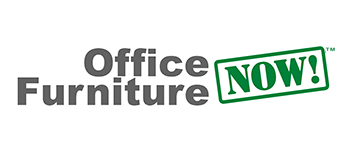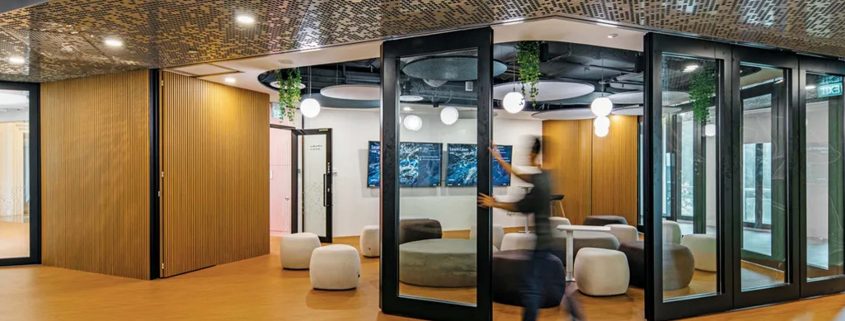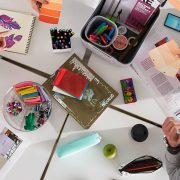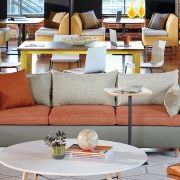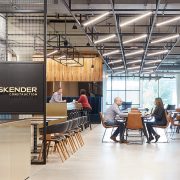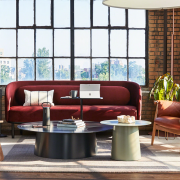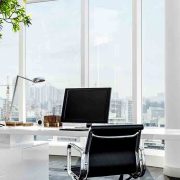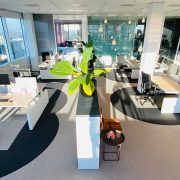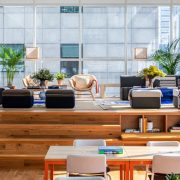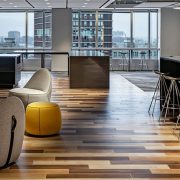Achieving A Flexible Workspace Design
Flexible workspace design provides opportunities for employees to better connect with one another and with your brand ethos. Working closely with a design team that understands your end goal will ensure that every element of the design engages your employees and reflects your corporate culture. Here are three key points to incorporate into your design strategy.
Build An Impressive User Experience
User experience (UX) refers to the impression a user has when interacting with a brand, an organization, a product, or a service.
As a consumer, when we enter a space that cohesively communicates a brand with highly functional furniture, art, color, and design, we feel effortlessly comfortable and begin to almost unconsciously bond with and anticipate the next best interaction. This is done in retail design to sell a product. It’s also done in hospitality design to broker a feeling of comfort.
What those spaces have synonymously conveyed is experiential interior design.
Experiential interior design partnered with a flexible workspace design becomes a powerhouse to improve both brand immersion and work efficiency. By allowing employees to experience variations on a theme through brand ethos and work placement, the impact upon workplace culture soars. Begin by integrating more choices about where and when your team works:
- Unassigned desks
- Cafe areas
- Casual-style rest areas
- Formal and informal meeting rooms
- Relaxing outdoor gathering spaces
An intentionally designed work environment has a great impact on people. Well-planned design solutions will create a comfortable environment where teams can confidently contribute to over-reaching goals for the company. Strategically create a flow where these spaces coexist allowing employees to flexibly choose where to work. Zones based on their work content encourage a deeper level of collaboration and corporate vested interest, making employees more dedicated and productive.
Engage Employees Through Creative Work Zones
Flexible workspace design raises the bar on employee engagement on a daily basis. By encouraging staff to spend time outside of their cubicles you can improve both mood and productivity.
Integrate privacy zones dispersed among work zones. For example, if a sales manager needs to phone clients or check the status of an order, proximity to soundproof phone booths can eliminate disruption by nearby coworkers and eliminate the task much faster.
Before you build specialized creative work zones, discover what your staff needs to be more successful. Each zone should be designed with your employees’ task requirements and comfort in mind. Ask the right questions and get your team’s input:
- Do employees need more private spaces?
- Do managers and training teams need conference rooms outfitted with high-definition digital monitors?
- Does your cafe accommodate informal team brainstorming sessions?
Support Greater Mobility
Mobile technology continues to allow employees to do their work on smartphones, laptops, and tablets from anywhere in a building, not just from their desks. To support your most mobile workers, provide a reliable wireless connection throughout the building.
This could be challenging if your office includes a lot of concrete, brick, stone, or tile features, as each material can interfere with WiFi signals. Wireless repeaters and other Wi-Fi signal extenders can help you overcome signal challenges and provide internet access to every employee—even those located in basement-level offices. Chairs and tables that include an embedded power source will prevent employees from having to find an outlet or return to their desks to charge their devices.
Innovation should be encouraged to happen anywhere. By supporting mobility through flexible workspace design immediate creativity will become effortless. It’s also important to give employees a place in which to connect with each other. In an agile and mobile workplace, the human connection is still important.
People appreciate opportunities to personalize their work area with family or pet photos. While this may not be possible without assigned seating, there are other ways that allow this type of personal connection and engagement. Implement digital screens for them to display photos, social media posts, and company news via removable flash drives at their chosen location.
And don’t forget that supporting mobility requires that employees have movable and lockable storage areas so that they feel their belongings are safe as they move from space to space throughout their work day.
 PROJECT MANAGEMENT: Our project management team is experienced and educated in a variety of tools and methodologies to help you visualize your design, reconfiguration, or relocation project. And our professional installation team is well equipped to handle any eventuality. Contact us at 512-448-3769 or experts@officefurniturenow.com
PROJECT MANAGEMENT: Our project management team is experienced and educated in a variety of tools and methodologies to help you visualize your design, reconfiguration, or relocation project. And our professional installation team is well equipped to handle any eventuality. Contact us at 512-448-3769 or experts@officefurniturenow.com
